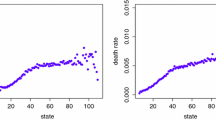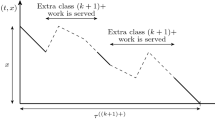Abstract
We consider the problem of finding a heavy and light traffic limits for the steady-state workload in a fluid model having a continuous burst arrival process. Such a model is useful for describing (among other things) the packetwise transmission of data in telecommunications, where each packet is approximated to be a continuous flow. Whereas in a queueing model, each arrival epoch,t n , corresponds to a customer with a service timeS n , the burst model is different: each arrival epoch,t n , corresponds to a burst of work, that is, a continuous flow of work (fluid, information) to the system at rate 1 during the time interval [t n ,t n +S n ]. In the present paper we show that the burst and queueing models share the same heavy-traffic limit for work, but that their behavior in light traffic is quite different.
Similar content being viewed by others
References
Asmussen, S. (1987).Applied Probability and Queues, Wiley, New York.
Asmussen, S. (1992). Light traffic equivalence in single server queues,Annals of Applied Probability,2, 3, 555–574.
Brandt, A., Brandt, M. and Sulanke, H. (1990). A single server model for packetwise transmission of messages,Queueing Systems Theory Appl.,6, 287–310.
Chung, K. L. (1974).A Course in Probability Theory, 2nd ed., Academic Press, Orlando, California.
Miyazawa, M. and Yamazaki, G. (1992). Loss probability of a burst arrival finite queue with synchronized service,Probability in the Engineering and Information Sciences,6, 201–216.
Pan, H., Okazaki, H. and Kino, I. (1989). Analysis of bursty traffic in ATM (preprint in Japanese).
Sigman, K. and Yamazaki, G. (1992). Fluid models with burst arrivals: a sample path analysis,Probability in the Engineering and Information Sciences,6, 17–27.
Wolff, R. W. (1989).Stochastic Modeling and the Theory of Queues, Prentice Hall, Englewood Cliffs, New Jersey.
Yamazaki, G., Miyazawa, M. and Sigman, K. (1993). The first few moments of work-load in fluid models with burst arrivals (preprint).
Author information
Authors and Affiliations
Additional information
Research supported by the Japan Society for the Promotion of Science, during the author's fellowship in Tokyo.
Research funded by C & C Information Technology Research Laboratories, NEC, and the International Science Foundation.
About this article
Cite this article
Sigman, K., Yamazaki, G. Heavy and light traffic in fluid models with burst arrivals. Ann Inst Stat Math 45, 1–7 (1993). https://doi.org/10.1007/BF00773664
Received:
Revised:
Issue Date:
DOI: https://doi.org/10.1007/BF00773664




